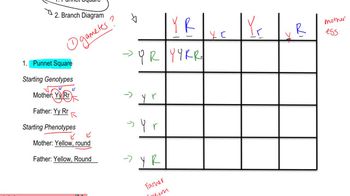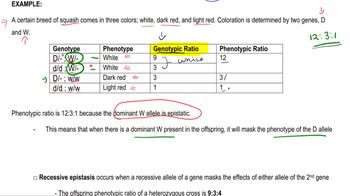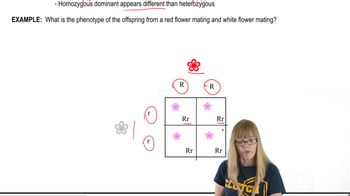Table of contents
- 1. Introduction to Genetics51m
- 2. Mendel's Laws of Inheritance3h 37m
- 3. Extensions to Mendelian Inheritance2h 41m
- 4. Genetic Mapping and Linkage2h 28m
- 5. Genetics of Bacteria and Viruses1h 21m
- 6. Chromosomal Variation1h 48m
- 7. DNA and Chromosome Structure56m
- 8. DNA Replication1h 10m
- 9. Mitosis and Meiosis1h 34m
- 10. Transcription1h 0m
- 11. Translation58m
- 12. Gene Regulation in Prokaryotes1h 19m
- 13. Gene Regulation in Eukaryotes44m
- 14. Genetic Control of Development44m
- 15. Genomes and Genomics1h 50m
- 16. Transposable Elements47m
- 17. Mutation, Repair, and Recombination1h 6m
- 18. Molecular Genetic Tools19m
- 19. Cancer Genetics29m
- 20. Quantitative Genetics1h 26m
- 21. Population Genetics50m
- 22. Evolutionary Genetics29m
3. Extensions to Mendelian Inheritance
Variations of Dominance
Problem 8f
Textbook Question
Textbook QuestionTwo genes interact to produce various phenotypic ratios among F₂ progeny of a dihybrid cross. Design a different pathway explaining each of the F₂ ratios below, using hypothetical genes R and T and assuming that the dominant allele at each locus catalyzes a different reaction or performs an action leading to pigment production. The recessive allele at each locus is null (loss-of-function). Begin each pathway with a colorless precursor that produces a white or albino phenotype if it is unmodified. The ratios are for F₂ progeny produced by crossing wild-type F₁ organisms with the genotype RrTt.
12/16 white : 3/16 green : 1/16 yellow
 Verified Solution
Verified SolutionThis video solution was recommended by our tutors as helpful for the problem above
Video duration:
49sPlay a video:
Was this helpful?
Key Concepts
Here are the essential concepts you must grasp in order to answer the question correctly.
Dihybrid Cross
A dihybrid cross involves two traits, each represented by two alleles, allowing the study of inheritance patterns for two genes simultaneously. In this case, the genes R and T are being analyzed for their interactions in producing different phenotypes. The F₂ generation results from crossing F₁ hybrids, revealing phenotypic ratios that reflect the combinations of alleles inherited from the parents.
Recommended video:
Guided course

Punnet Square
Epistasis
Epistasis occurs when the expression of one gene is affected by another gene, leading to modified phenotypic ratios. In the context of the question, the dominant alleles R and T may interact in such a way that they influence pigment production differently, resulting in the observed ratios of white, green, and yellow phenotypes. Understanding this interaction is crucial for designing pathways that explain the F₂ ratios.
Recommended video:
Guided course

Epistatic Genes
Phenotypic Ratios
Phenotypic ratios represent the relative frequencies of different phenotypes in the offspring of a genetic cross. The specified ratios of 12/16 white, 3/16 green, and 1/16 yellow indicate how the combinations of alleles from the R and T genes lead to varying expressions of pigment. Analyzing these ratios helps in constructing hypothetical pathways that account for the observed outcomes based on the genetic interactions.
Recommended video:
Guided course

Mutations and Phenotypes

 4:37m
4:37mWatch next
Master Variations on Dominance with a bite sized video explanation from Kylia Goodner
Start learningRelated Videos
Related Practice


